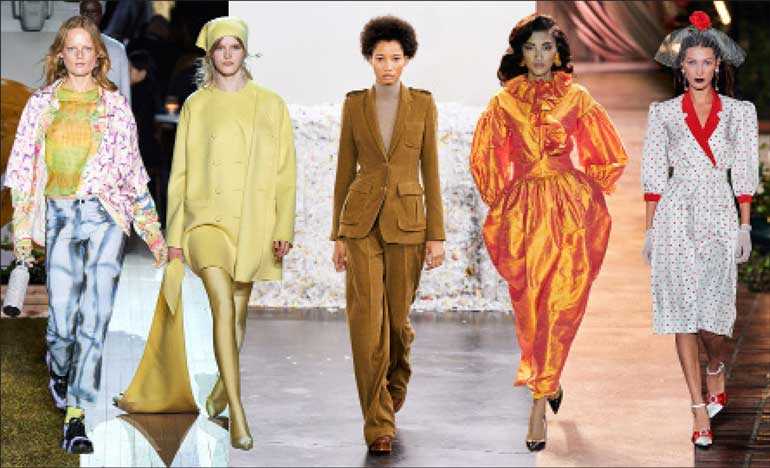Thursday Apr 17, 2025
Thursday Apr 17, 2025
Thursday, 23 April 2020 00:00 - - {{hitsCtrl.values.hits}}

Between the end of February and the beginning of March, however hard we tried to hold on to it, we couldn’t, we had to let go of fashion as we knew it. It was a good-bye and today it’s like standing before  River Jordan, with every hope that we will cross over to the Promised Land. Eyes strained in bewildered awe to see, and hoping to say hello to a new realm of fashion, which maybe the new normal. I must say I am totally stoked to see that and I have a good feeling that it’s happening.
River Jordan, with every hope that we will cross over to the Promised Land. Eyes strained in bewildered awe to see, and hoping to say hello to a new realm of fashion, which maybe the new normal. I must say I am totally stoked to see that and I have a good feeling that it’s happening.
Fashion as we originally knew, which stood for self-expression at different levels of society, has now shut down. There may even be a hint that the biggest luxury houses are making masks currently to help make a difference to society, it may be a prophetic sign of what should come after this, a new direction of fashion fuelled with compassion and personalisation.
There definitely is a huge need to overhaul this global industry. The shutdown maybe the catalyst to shut the engine off, reboot and start again. Though it was a much-needed reboot, the fact that it happened at such a speed was an unexpected reality to everyone, including leaders of large fashion houses around the world.
Many of them now find themselves having shut down their current facilities and making the goods needed for the current crisis. Though this seems temporary, it may actually be a spiritual sensitisation of sorts that may hold them in good stead as this transformation to the new reality takes place.
We witnessed a systematic decimation of fashion since the beginning of this year, with early January seeing greatly reduced crowds for the new season of Fashion Week which started in New York to London where the X52 movement took to the streets to ban Fashion Week for 52 weeks for being irresponsible. By the time we reached Milan, Fashion Weeks were being hosted behind closed doors with no audience.
What is fashion up to now?
So what is fashion up to now? In today’s reality, the most common object visible on us is probably a mask and maybe a PPE (Personal Protection Equipment) so both the face and the body are hidden in unison, where fashion was supposed to celebrate your look and your personal expression is now completely covered up. Could this also represent the reality of the state the fashion industry at present? No one wants to see what fashion has on offer.
The confines of our own home may give us time to judge not only what we are wearing but also the impact of what we are wearing. And questions like ‘When did we buy it?’ ‘How was it made?’ ‘How often will I wear it?’ ‘What will I do with it afterwards?’ will be instrumental in giving the fashion industry a new direction, which is currently not on a great path. It really is important to dig deeper in our slightly slowed-down state, on the impact our purchase of garments have on the environment and on the design industry.
This is the time to magnify the questions and glorify the answers so that collectively fashion can change direction. Fashion will only change its path if we collectively question it. It’s time the validation that fashion brings to our personal identity be the same validation we bring to question how the fashion that we consume is created. It’s time we become the stakeholders in the new direction of global fashion.
Riding a tiger
Fashion as I last remember, is like an analogy of a tiger that has the designers, the retailers, the manufacturers and the financial owners riding on it, with everyone knowing that if you get off now you will be eaten, while knowing this ride may not last. And this approach to grow the industry is what makes it look almost self-destructive.
Most brands or retailers are now either part owned or driven by private equity firms, with share price forecast as the key indicator that drives every decision in fashion development even if it is at the expense of goodness, the craft and value of design associated with the industry. My point is that a steady profitable growth is important as that will help bloom the design product, but achieving overnight profitability through opportunistic ways may not really have a long-term view of growth.
It’s been proven that profitability can be achieved with a sound business model which has ‘goodness’ at the core of it. Every time I would see a fashion house selling their label to a private equity firm I would wait, hoping they will maintain the design language that is instrumental in connecting with the consumers or not that it is sacrificed or diffused in order to grow the number of stores.
If business is driven by numbers senselessly, then there will a hidden objective to amplify the ‘need to buy’, driven by aggressive discounts presented as a ‘good deal’ to suspecting fashion consumers. This promotes wrong culture among consumer to completely sacrifice the design credential of the piece they were to buy. It is an altered state of fashion consumption and not a normal one that a society is supposed to possess.
Fashion is and will always be an emotional buy, but if driven with a rationale, FMCG view, to sell, then it surely is a departure from the normal pattern how fashion was supposed to be sold. Deep down you will always buy fashion which connects with your emotional thinking and your outlook to life. The relationship with fashion starts here.
Fashion will remain need as key need of society, as it connects to clothing. This has given birth to a $ 785 billion global industry at the last count. It’s important to note how much of this was due to a stimulated need created through aggressive discounts and how much was part of the designed product that found favour in the arms of appreciative fashion consumers.
Every garment should be created as a ‘solution’
Today fashion needs to wake up and start from the basic; it carries the potential to build itself back up, but with a shift that every garment should be created as a ‘solution’ rather than a ‘problem’ by designers and their supply chain.
Designing is a meditative and a spiritual experience, as to create something represents life and it’s a gift that every person who designs carry. It is supposed to lead to something good. Hence every manifested design product should by default be a solution to a need. But misrepresentation of it has created the  opposite, a problem. Each garment produced today first poses itself as a threat and as a problem to the environment or society purely because of the objective behind its creation. This shift from problem to a solution is what should be the new normal in the global fashion industry. It starts with simple shift in mindset.
opposite, a problem. Each garment produced today first poses itself as a threat and as a problem to the environment or society purely because of the objective behind its creation. This shift from problem to a solution is what should be the new normal in the global fashion industry. It starts with simple shift in mindset.
Perfect time to recalibrate
It’s a perfect time to recalibrate, when factories are lying empty, retail houses are closed, and stock markets are not trading with enthusiasm, it’s a perfect time for fashion to plan its rise once again, void of all external influences that corrupted it. This may be a perfect blessing in disguise. To think of it, fashion should have never needed external policing to check whether it is sustainable if it followed the purity of the design process to create a solution.
In every country, at every level of the society there is an opportunity for clothing and fashion to exist. At the top of the chain are the fashion houses, some of those have existed for over 200 years ago. The sudden need to increase the speed of selling fashion to a larger consumer groups has come about only in the last 20-30 years and that has corrupted the supply chain of fashion. Hence, it’s time for the design language to connect with a consumer base, as there exists one at every level of the society who values it and is willing to pay for it.
It’s time fashion bonds with its consumers at a good emotional level rather than purely a commodity transaction, the deeper connection with the consumer will result in an enhanced long-term consumer value. Even if it requires creating clothing essentials that will complement social distancing. It’s a good time to build a fashion brand which is thought through and responsible. I wait with bated breath to see the ‘new’ of fashion or the new normal!
Discover Kapruka, the leading online shopping platform in Sri Lanka, where you can conveniently send Gifts and Flowers to your loved ones for any event including Valentine ’s Day. Explore a wide range of popular Shopping Categories on Kapruka, including Toys, Groceries, Electronics, Birthday Cakes, Fruits, Chocolates, Flower Bouquets, Clothing, Watches, Lingerie, Gift Sets and Jewellery. Also if you’re interested in selling with Kapruka, Partner Central by Kapruka is the best solution to start with. Moreover, through Kapruka Global Shop, you can also enjoy the convenience of purchasing products from renowned platforms like Amazon and eBay and have them delivered to Sri Lanka.
Discover Kapruka, the leading online shopping platform in Sri Lanka, where you can conveniently send Gifts and Flowers to your loved ones for any event including Valentine ’s Day. Explore a wide range of popular Shopping Categories on Kapruka, including Toys, Groceries, Electronics, Birthday Cakes, Fruits, Chocolates, Flower Bouquets, Clothing, Watches, Lingerie, Gift Sets and Jewellery. Also if you’re interested in selling with Kapruka, Partner Central by Kapruka is the best solution to start with. Moreover, through Kapruka Global Shop, you can also enjoy the convenience of purchasing products from renowned platforms like Amazon and eBay and have them delivered to Sri Lanka.